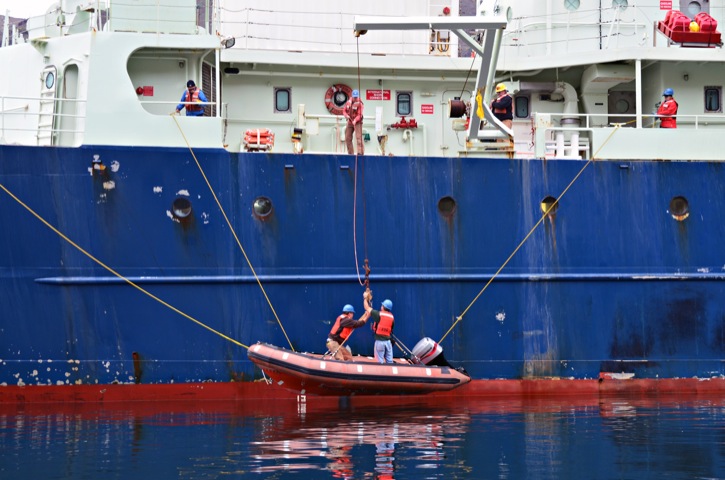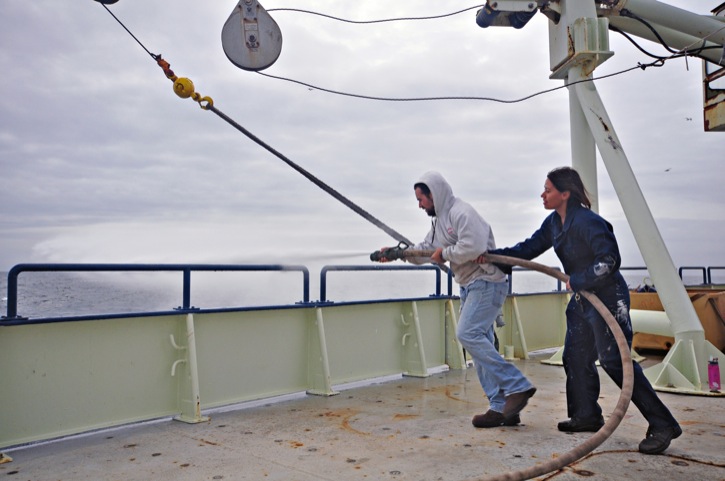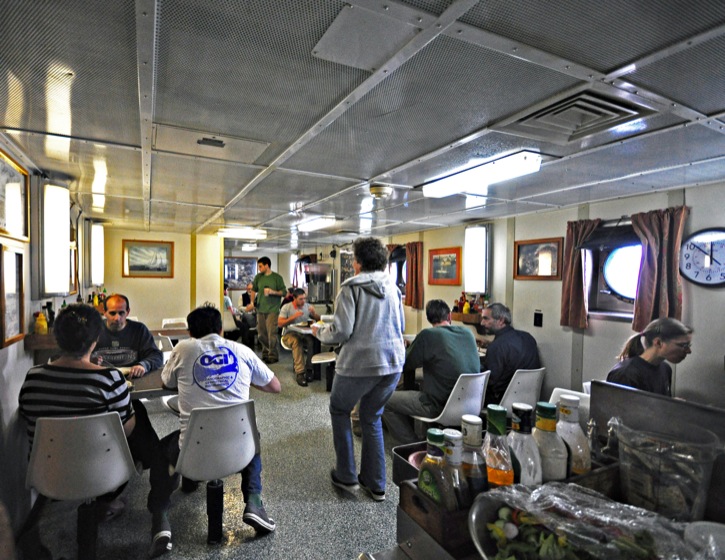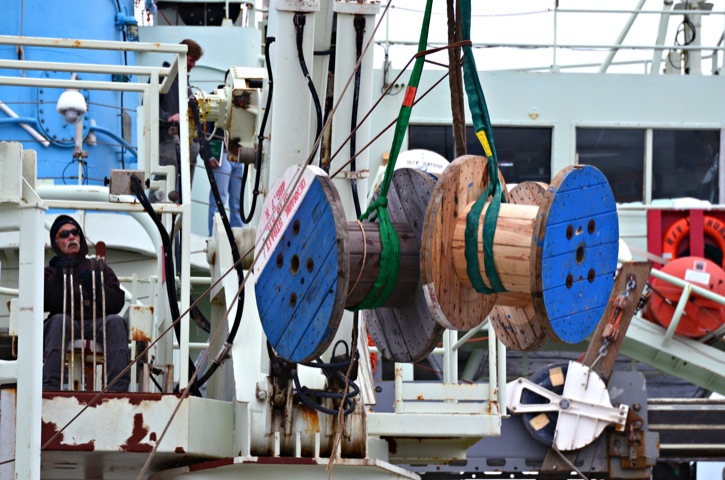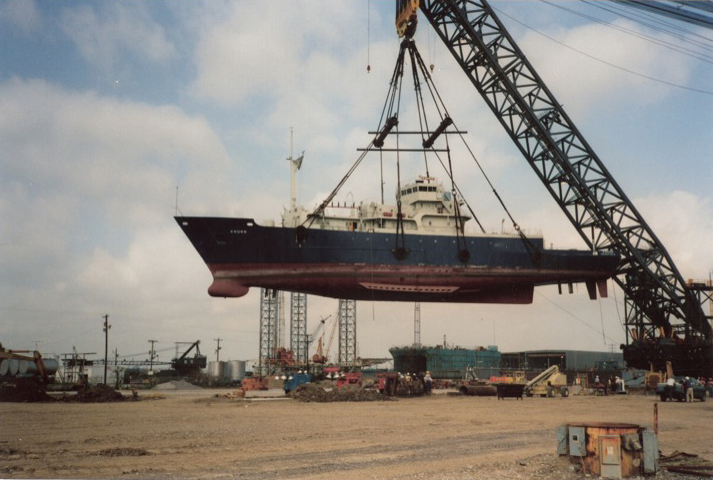September 12, 2011I was listening to sea stories after lunch—well, literally they were land stories—about port-stops told by Pete the Chief Engineer, Kyle the bosun, Second Mate Jen, and the Skip. Apropos of what, I don’t exactly remember, but in the course of five minutes, they reminisced about shoreside, uh, activities in Namibia, Malta, and Nuuk, Greenland. These people have been all over the globe aboard this vessel. They mention Guam and the Galapagos, the Dardanelles and the Drake Passage, the Mid Atlantic Ridge and Flemish Caps the way the rest of us might mention our week’s cruise to Nantucket. Knorr has worked all the world oceans and most of its seas. She’s been to the ends of the Earth—in the Southern Ocean near Antarctica and north of 80° North. By 2005 she’d logged one million nautical miles in the service of science.
Owned by the U.S. Navy and known officially as an Auxiliary General-Purpose Oceanographic Research vessel, she’s operated, manned, and scheduled by WHOI. Her keel was laid in 1967 in Bay City, Michigan, and, christened R/V Knorr after Ernest Knorr, the Navy’s pioneering 19th-century cartographer; she slipped down the ways at the Defoe Shipbuilding yard a year later and proceeded to log a long, impressive list of accomplishments (see WHOI website).
By 1989 it became clear that, given maturing ocean science, its evolving technology, and the multiple missions Knorr was being assigned, a bigger ship was required. So she was sent to the McDermott Shipyard, Amelia, Louisiana, where she was cut vertically in half, and ten meters of bottom, topside, decks, and houses were inserted. You can still see the welded seams on the maindeck, starboard side, where the CTD is launched. And while they were at it, McDermott installed the new computer-controlled dynamic positioning system, re-designed bow thruster, and new propellers.
Most commercial ships are built for a single task—tankers, car carriers, freighters. Ocean research ships are also purpose built. You can’t just adapt any old ship. However, ocean research, like the science itself, is not singular. Knorr needs to be uniquely versatile, to serve the geologist who wants to drill deep bottom cores, the physical oceanographer who wants to lay moorings and do about 300 CTD casts in a month, and the engineers who want to test the latest remotely operated underwater vehicle. Among other specialized tasks, Knorr must routinely do what other deep-sea vessels do only in the most unusual circumstances or in emergencies—stop in the middle of the ocean for hours, days at a time while all manner of measuring devices are deployed overboard. This requires a specialized propulsion system, those thrusters we talked briefly about earlier. Two in the stern and one in the bow, each thruster can rotate 360° (“azimuthing” is the fancy term) to direct thrust in any and all directions. She can spin in her own length, move sideways, and hold position within one meter in all but unreasonable weathers. This of course demands equally specialized ship-handling skills. When I first met Knorr several cruises ago, I was deeply impressed not only by that skill but by the confident informality with which it was being performed. I’m almost used to it by now, and a new observer could be excused if he/she concluded that that’s how it goes down on all R/Vs. It does not.
It’s remarkable also to watch the deck crew, overseen by Kyle the bosun, lift high overhead and move really heavy objects, many ton’s worth of things in all shape and sizes, containers, for instance, of the sort trucks transport. There’s a heavy-duty extension-arm crane mounted on the transom and another one on the deck above. There’s a winch on the aft deck with a drum about the size of a drainage conduit. Then there’s the versatile “A-frame” on the transom for all manner of lifting, especially useful for mooring deployment. When shoreside crane operators lift and move things, weight is their main concern; land doesn’t move. Out here, however, they’re lifting and moving heavy objects from place to place while the ship rolls and pitches and lurches. And the ship lifting on a wave then dropping into the trough inflicts tons of sudden shock load on the crane and wire. An instant of inattention by the operator, and the airborne object can fly out of control with disastrous, possibly deadly result.
I’d like to write more later about the various departments—engineering, galley, deck, bridge, etc.—the people and their braided relationship, but for now I’ll let the photographs carry the physical description of the ship more revealingly than language.
* * * I’m not sure what it is about ships and sea-boats that evoke strong, romantic emotion. Perhaps it’s that they travel across big waters in utter isolation, where all lives aboard depend on their buoyancy and watertight integrity. It’s no coincidence, given such isolation, that ships have made good literary microcosms (Coleridge, Conrad, Melville) through several centuries of Western Literature. Perhaps it’s aesthetics. In the days of sail, even the most damp-souled literalist was stirred by images of a full-rigged ship running before a whole gale, everything set to the royals. (By the way, “ship” had a technical meaning—a vessel of three or more masts with square sails on all masts—that has carried over to modern, imprecise usage.) In those days, going to sea left a death-like absence at home. Maybe the sailor would return, maybe not. That isolation is less complete today thanks to satellite communications. And modern ships are not beautiful in the same obvious way as Cutty Sark or Flying Cloud. But that feeling abides nonetheless. It’s not hip to talk about such things, and some might scoff outwardly at the notion, but I think many of the people aboard love this ship. I do, and I’m only a dilatant. I guess I’m thinking about these abstractions because there’s an element of melancholy to the story of the Knorr. Her working life is approaching its end. Even now a new generation of research vessel is in the design stages to replace Knorr and her sister ship Melville. Knorr at the breaker’s yard is too sad to contemplate—the Skip doesn’t even want to talk about it—but all life, ships and people, are ultimately replaced by the new. One hears two years, sometimes five. I hope it’s the latter, but now I don’t want to talk about it, either. So here are some cold-eyed nautical particulars, instead.
Last updated: December 27, 2011 | |||||||||||||
Copyright ©2007 Woods Hole Oceanographic Institution, All Rights Reserved, Privacy Policy. | |||||||||||||


